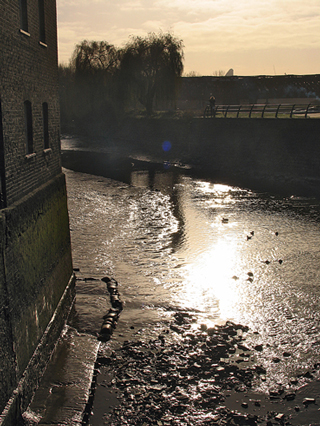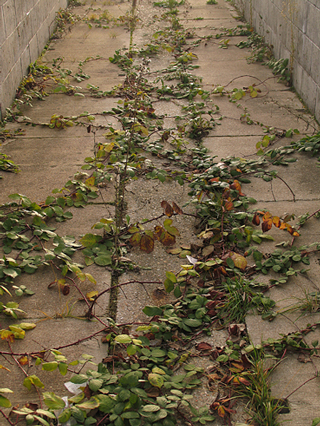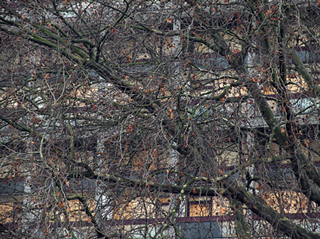Human Flower Project
On the Rim
John Levett tracks the “inherent restlessness” of plants, people, structures, de-structures—and memory—along the Thames’ tributaries.

Northern Approach
Photo: John Levett
By John Levett
Back in the ‘80s Paul Burwell [RIP], Anne Bean and Richard Wilson formed the Bow Gamelan Ensemble, described once as “a multi-media urban-junk-and-pyrotechnics percussion trio” and famously performing ‘Concrete Barges’ at Rainham Marshes on the Thames Estuary and coming close to self-drowning. I read about Paul Burwell’s death in an edition of The Wire sometime last year. He’d moved up to Hull (something about estuaries) and had fallen into a routine of alcohol consumption that contributed to his early death.
It’s curious how one often uses names of groups, products, organizations as a simple matter of naming without considering their origin. It was only last week that I clocked the London 2012 trademark and noticed that it actually pictured the numerals ‘2012’ having previously taken it as a random splash of flashes that was a signifier for something I wasn’t going to research. I’m currently going through the Beatles archive for long defunct cultural references and turns of speech. Thus it came as a slap on the forehead when I realised one crisp morning last January that Bow Gamelan referred to Bow in London’s East End.
The occasion was a detour organised for one of the urbanist groups that I convene. We met at Three Mills not far from Bromley-by-Bow tube station, and it was during the introduction that Burwell, Gamelan and Bow came together. Our group had done some work last year in the East End around Shadwell and the liminal environments close by the Isle of Dogs and we were back there to explore the cuts through to the Thames estuary.
 Bow Creek
Bow Creek
Photo: John Levett
There is a common trope that the Thames estuary is now nothing else but executive apartments and the usual retail boutiquery that services them with an accompanying clearing away of all that had gone before—an eradication of the palimpsests of history. Not so. This is not to eliminate the the possibility that such will be the result but it’s far from a done deal as yet. First they come for the views (e.g. Greenwich through to Woolwich on the south bank) then for the hinterland: in this case the rivers and canals that outflow into the Thames from Greenwich Reach, Blackwall Reach through to Thames Gateway. Bow Creek runs down to Learmouth just by Canning Town but branching off it is Limehouse Cut which enters the river close by Narrow Street (Dickens, The Grapes).
I walked Limehouse Cut back in the late ‘90s as a result of seeing the work of the landscape painter Andrew Smith at Kettle’s Yard in Cambridge. I’m not drawn to contemporary landscape painting much but Andrew Smith’s work led me in. (I was reminded of him a few weeks ago when at Kettle’s Yard I stopped by the current Bridget Riley show; Smith was once an assistant to Riley.) He has written of his attraction to the East End landscape describing it as ‘almost rural’ in places. There was one painting I remember of a boy looking skyward beside Limehouse Cut and I wanted to inspect that place—where he stood, what he saw, from where he might have come. I recall walking from Stratford bus station through to where the Cut passes under Bow Road. I’d never walked that way before and I came to regard it as an ‘unremembered place’: one that exists only in an imagined moment when one might have walked that path—an invention of a memory. I started from that point making a long series of works, both image and text, on created memory which occupied me for the next five years.
 Three Mills
Three Mills
Photo: John Levett
At a Private View of one of our group exhibitions I was involved with earlier this year I was asked why the works referred so little to urban ecology as opposed to the built fabric, whether it was a ‘policy’ of the group, a definite decision to avoid the rural in the urban. Truth to tell, I’d never noticed its absence but the student was right—as a group we had avoided (unconsciously on my part) the natural environment. I took the opportunity to look through my archive to see how pronounced the bias was in my work and it was considerable. It was as if I had to make conscious choices on the natural environment’s behalf: “Today I shall photograph the tree. Tomorrow I shall pay attention to the verge.” Why so? I talked with a colleague and he ’fessed up to a similar tendency (although on his part he used the term ‘partiality’).
 Twelve Trees
Twelve Trees
Photo: John Levett
Later I became more ruminative about the matter. It’s certainly true that I’m drawn towards the built fabric but I’m also deeply aware of the interstices of that environment and of the way in which each successive layer of urban razing (I refuse to use ‘regeneration’) gives evidence of its various occupations. On its simplest level the surprise of a Hawksmoor pulls us into the church but it’s the deposits on a gravestone that will draw us into the graveyard. It’s the sites of religious practice that affect our sensibility to the urban conglomeration if by no other device than from our sitting in it and observing that which has now become apart, the urban busy-ness as alien, as (archaically) oppugnant.
Equally, it is the randomness of the ancient city that creates the outposts of redundancy that attract re-gain and re-growth. the left and ignored that are host to accretions, the centuries of sprawl that leave margins for invasion, the chipped brick and the hammered spike that give footholds for the organic, the no-longer-travelled cut that is host to the biotic.
Does this mean that, far from ignoring the ecological, my work is a seamless mesh of the grown, the grown-over and the grown-upon? I doubt it, but I returned to the work I’d done in the late ‘90s on the Cut. It was, I had forgotten, all done on film that I’d processed at the long-dead-but-of-happy-recall Cambridge Darkroom Gallery and that discovery, as these things go, took me through my archive of old film. That was the rest of the day gone.
I’d forgotten that these were my early years of living in Cambridge and Cambridge was the star. I’d, inevitably, walked The Backs, snapped King’s Chapel, Trinity College’s Wren Library, the Clare College Bridge, the sluice near Fen Causeway, the Cam near Newnham, every acre of the Botanical Gardens, the woods near Cherry Hinton—everything clothed in foliage (ancient and modern), framed in branch flowered and bare—quite the nature boy!
 Teviot Street
Teviot Street
Photo: John Levett
I went back to the more recent detour along Limehouse Cut and I think I’ve done myself injustice. Much of that day’s shooting is a recognition of the ‘lineage’ of the built and the natural domains; acknowledging from where each comes, recognizing their competition, tracing where each is growing. The Cut is artificial but its content isn’t and neither is its use. It would be commonplace to say that the Cut is pure function but in use that would be reductive. At the same time it would be stretching terms to describe its length as an edgeland; part is but it’s a space that is contested naturally, historically and imaginatively, seemingly each decade. It passes, almost geometrically, through the East End but is uncontained by its geometry; indeed, at points it contains that which is on each bank in its own quarter. restrains slippage, imposes boundaries; allows the organic its inherent relentlessness.
 Under Common Lane
Under Common Lane
Photo: John Levett
At some point in my life I will be given the quality of slowness accompanied by pausing and eventually stopping. This will result in an intimate space beyond which I will no longer be able to travel. This will test me. I’ll no doubt devise a theory of it, convene a seminar on it, engage in discussion on it, create an image archive of it. Prior to this halting I’m currently contemplating making meaningful contact with voluntary pausing: paying attention, walking backwards through my practice. Revisiting is what I’m currently doing. I’m unearthing what I’ve done since the mid-‘90s. It’s good stuff which I’m proud of and want to refashion in some way. This isn’t a trip into the old-time comfort zone; rather it’s a picking up on the sensibility I had in that decade when I seemed to segue from one area of expression to another without concern. Currently I’m thinking too much. Enough.
Comments
Beautiful post and photographs.


I am glad for your student’s observation and look forward to seeing more photos from your “nature boy” period!